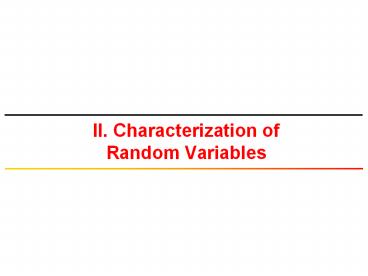II. Characterization of Random Variables - PowerPoint PPT Presentation
1 / 29
Title: II. Characterization of Random Variables
1
II. Characterization of Random Variables
2
Random Variable
- Characterizes a random experiment in terms of
real numbers - Discrete Random Variables
- The random variable can only take a finite number
of values - Continuous Random Variables
- The random variable can take a continuum of values
3
Probability Mass Function
- Only Suitable to characterize discrete random
variables
4
Cumulative Distribution Function
5
Probability Density Function
- Used to characterize Continuous Random Variables
6
Uniform Random Variable
7
Gaussian Random Variable
- Many physical phenomenon can be modeled as
Gaussian Random Variables most popular to
communication engineers is AWGN Channels
mean
standard deviation
8
Exponential Random Variable
- Commonly encountered in the study of queuing
systems
9
How to Characterize a Distribution
Client Tell me how good is your
network? Salesman Well, P(Delaylt1)0.1,
P(Delaylt2)0.3, P(Delaylt3)0.2, Client
Hmmm So what does this really mean? Salesman
How can I explain this?
10
Mean of Random Variables
Client Tell me how good is your
network? Salesman Well, The average delay per
packet is 1 sec Client Hmmm So what does this
really mean? Salesman If you need to send 100
packets, they will most likely take 100 seconds
11
Mean of a Random Variable
- Discrete Random Variable
Continuous Random Variable
12
Example
- Consider a Network where the delay D is either
1 or 5 seconds - i.e., PD 1 0.3, PD 5 0.7
- PD 0, 2, 3, 4 0, PD 6, 7, 8, 9,
0 - What is the mean delay?
- Let assume 100 packets, then most likely
- 30 packets will be delayed for 1 sec
- 70 packets will be delayed for 5 sec
- Therefore 100 packets will most likely take
30x170x5 380 sec - Average Delay 380/100 3.8 sec
- ED 1xPD15xPD5 3.8 sec
13
Moments of a Random Variable
- Discrete Random Variable
Continuous Random Variable
14
Central Moments
- Discrete Random Variable
Continuous Random Variable
15
Variance
- Variance is a measure of random variables
randomness around its mean value
16
Conditional CDF
- Define FXAx as the conditional cumulative
distribution function of the random variable X
conditioned on the occurrence of the event A, then
Remember Bayess Rule
17
Conditional CDF Example
- Consider a uniformly distributed random variable
X with CDF
FXx
1
x
0
1
Calculate the conditional CDF of X given that
Xlt1/2. In other words we would like to compute
FXXlt1/2x
18
Conditional CDF Example
- Consider a uniformly distributed random variable
X with CDF
FXx
1
x
0
1
Calculate the conditional CDF of X given that
Xlt1/2. In other words we would like to compute
FXXlt1/2x
19
Conditional CDF Example
- Consider a uniformly distributed random variable
X with CDF
FXx
1
x
0
1
Calculate the conditional CDF of X given that
Xlt1/2. In other words we would like to compute
FXXlt1/2x
20
Conditional CDF Example
- Consider a uniformly distributed random variable
X with CDF
FXx
1
x
0
1
Calculate the conditional CDF of X given that
Xlt1/2. In other words we would like to compute
FXXlt1/2x
FXx
1
x
0
1/2
21
Exercise
- For some random variable X and given constants
a, b such that altb
22
Conditional PDF
- Define fXAx as the conditional probability
density function of the random variable X
conditioned on the occurrence of the event A, then
23
Conditional PDF Example
- Consider a uniformly distributed random variable
X with CDF
fXx
1
x
0
1
Calculate the conditional PDF of X given that
Xlt1/2. In other words we would like to compute
fXXlt1/2x
fXXlt1/2x
2
1
x
1/2
24
Exercise
- For some random variable X and given constants
a, b such that altb
25
Conditioning on a Characteristic of Experiment
- Conditioning does not necessarily have to be on
the numerical outcome of an experiment - It is possible to have qualitative conditioning
based on a characteristic of an experiment - Example Consider a random variable X that
represents the score of students in a given
course - Conditioning based on experiment outcome
- The distribution of grades given it is greater
than 80 (i.e., FXXgt80x) - Conditioning based on experiment characteristic
- The distribution of grades given the gender of
students (i.e., FXMx)
26
Conditioning on a Characteristic of Experiment
- Consider a set of N mutually exclusive events
A1, A2,, AN. Suppose we know FXAnx for n1,
2, , N. Then
The unconditional CDF/PDF is basically the
conditioned CDF averaged across the probability
of occurrence of conditioning events Example Fo
r a bit b sent over a communication channel and
the received voltage r Prlt0Prlt0b1Pb1P
rlt0b0Pb0
27
Conditioning on a Characteristic of Experiment
- Consider a set of N mutually exclusive events
A1, A2,, AN. Suppose we know FXAnx for n1,
2, , N. Then
Discrete Random Variable
For a continuous random variable P XxAn0, P
Xx0 resulting in an undetermined expression
28
Conditioning on a Characteristic of Experiment
- Consider a set of N mutually exclusive events
A1, A2,, AN. Suppose we know FXAnx for n1,
2, , N. Then for a continuous random variable
29
Conditional Expected Value
- The expected value of a random variable X
conditioned on some event A
Discrete Random Variable
Continuous Random Variable































